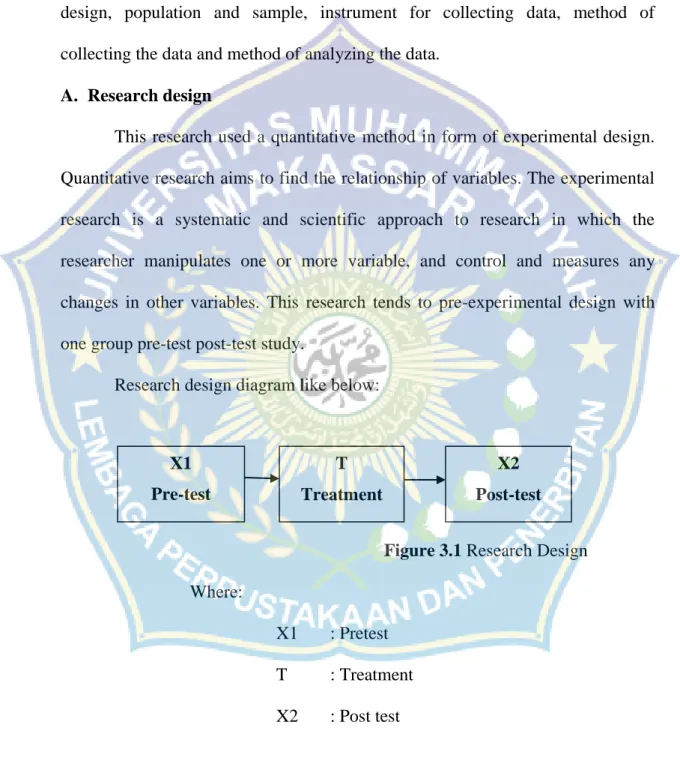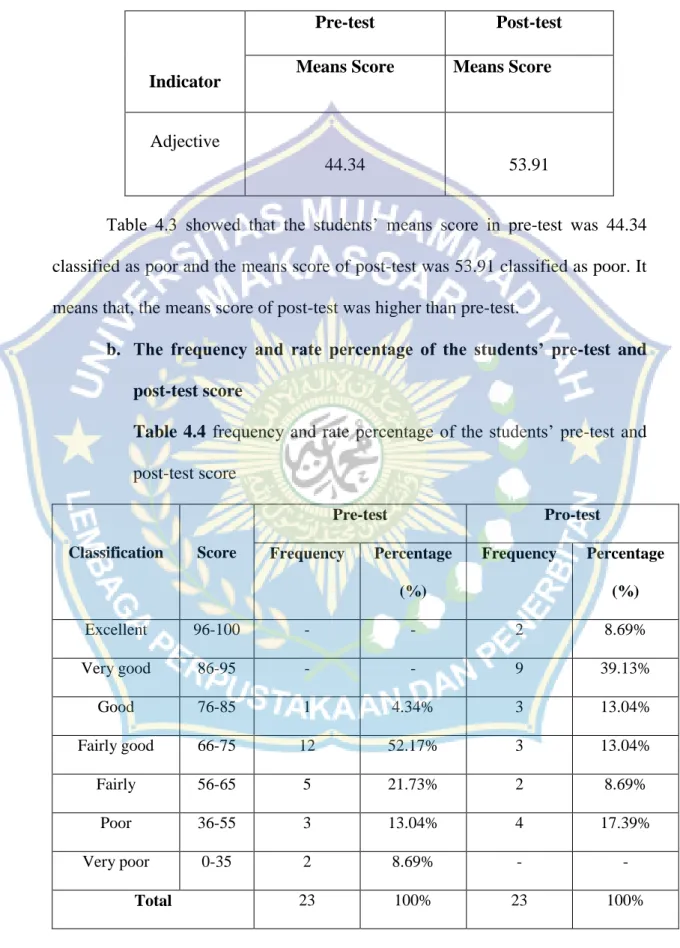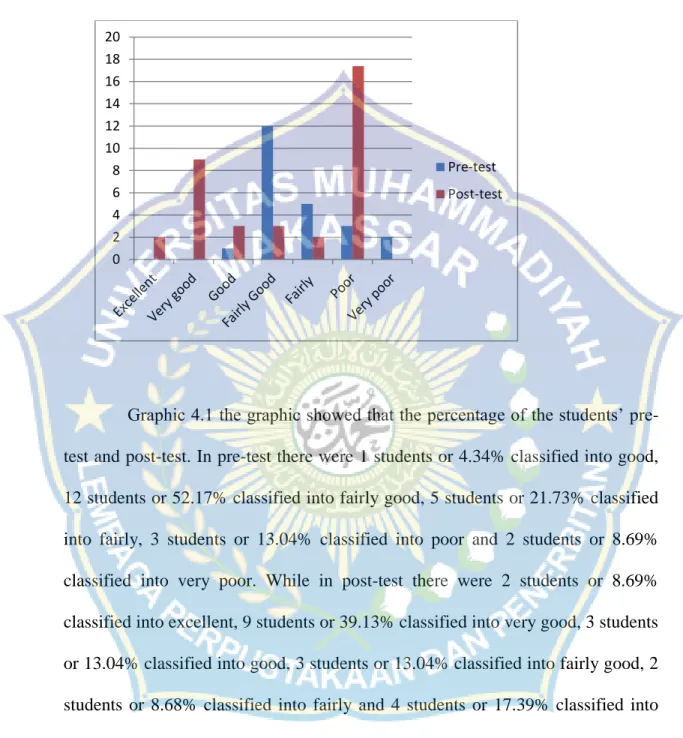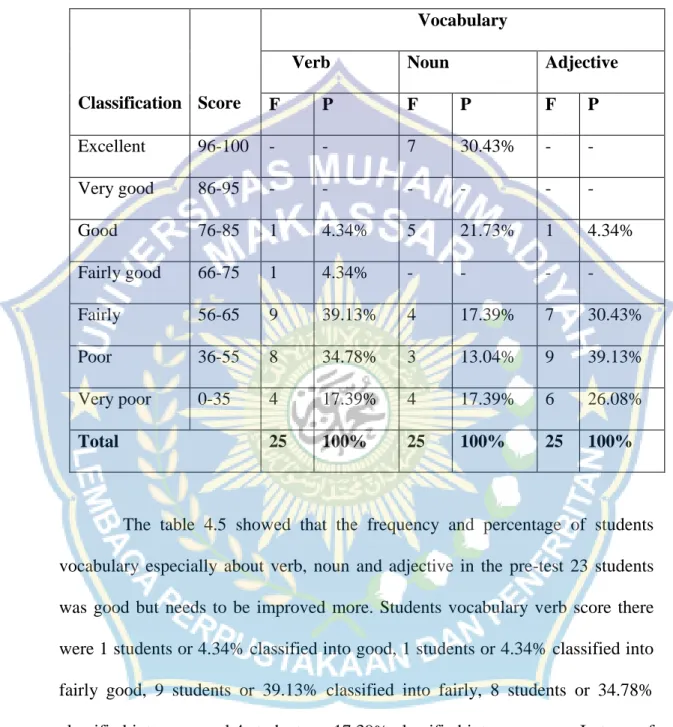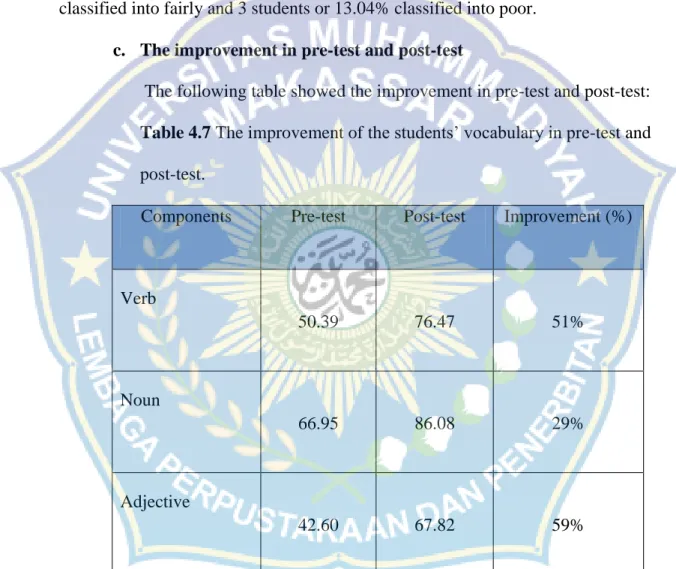The use of word wall media to improve the students' vocabulary in reading skills at the seventh grade of Mts. Negeri Bantaeng to find out improvement of the students' vocabulary about the use of word walls media. It can be concluded that the use of Word Walls Media can improve students' vocabulary performance, especially for students at Mts.

Problem statement
A word wall is a collection of high-frequency, age-appropriate sight words organized into groups or categories and placed on the classroom wall for children to easily see and learn. The main purpose of the word wall is to help students develop visual word recognition so that they can recognize them at a glance (Huebner & Bush, 1970). In addition, word walls are also a visual element that helps students remember the connections between words (. Callella, 2001), retain word knowledge and eventually read them automatically (Ehri, 2005).
Objective of the research
Significant of the research
Scope of the research
- Types of vocabulary
- Aspect of vocabulary
- Teaching vocabulary
- The importance of vocabulary
- Vocabulary development
- Principle of teaching and learning vocabulary
- The reason for learning vocabulary
- The kinds of media
According to Nation (2003:25) he found that productive vocabulary refers to the words that students can pronounce. Words that students understand and can pronounce correctly and use constructively in speaking and writing. It is therefore important that students know the usual context in which the words appear.
Word walls
- Definition of word walls
- Word Walls Strategy
- Word wall as media of teaching vocabulary
- The goals of word wall
- The steps to make of using a word wall
By using the word wall method, it is expected that students can increase the understanding of English vocabulary without depending on the use of a dictionary or even the meaning of the word given by the teacher. According to Copper & Kiger (2003), a word wall is a collection of age-appropriate high-frequency sight words, organized into groups or categories, and placed on the wall of a classroom so that children can easily see and learn them. Furthermore, Green (1993) argues that word wall helps create a busy environment for students and can be a wonderful tool designed to promote group learning.
In terms of the above definition, a word wall is a systematically organized collection of words displayed in large letters on a wall or other large display in the classroom. A word wall is a continuous, organized display of key words that provides visual reference for students throughout a unit of study or a term. A word wall should be organized in a way that is useful for students with additions that reflect the skills or concepts being taught.
Teachers are encouraged to be creative in designing a word wall so that it engages the students and enhances their learning. Doing a word wall means being selective and limiting the words that are essential to the study unit. Doing a word wall means students have time to practice and write with the words.
Making a word wall means using a series of review activities to provide enough practice so that the words become automatic for students.
Reading
Definition of reading
Promote independence on the part of young students as they work with words in writing and reading. Provide a visual map, help children remember the connections between words and characteristics that will help them form categories. Use favorite words that are most appropriate for a particular topic so that they are easy to remember.
Make it useful by using this word often in different activities such as listening, speaking, reading and writing. Make it easy to see, to write the writing q which is large and placed on a wall in the classroom. Clarkand Sandra in Burhana (2010:7) found that reading is an active cognitive process of interacting with print and monitoring comprehension to establish meaning.
Jeremy Burhana (2010:7) found that reading is an exercise dominated by the eyes and the brain. The eyes receive the message on the printed page and the brain must then process or process the meaning of the message. Sahriana (2010:8) notes that reading is fundamentally concerned with meaning, especially the transmission of a message from the writer to the reader.
From the definition above, I will conclude that the definition of reading is an interactive process of getting information and ideas from the author with the written text.
Kinds of reading
In oral reading the students will gain experience in producing the sound which should be practiced as much as possible. Through oral reading the students can improve their mistake in pronunciation, intonation, and through reading they can increase their vocabulary.
Reason of reading
The Vocabulary Related to the Curriculum at SMP/MTS
Conceptual framework
Hypothesis
Research design
The population of this research has taken the seventh grade of Mts. Negeri Bantaeng in the academic year 2019-2020 which consisted of 47 students. There were two classes in the seventh grade as the population of the research VII A and VII B. The researcher used purposive sampling technique from class VII B, the total number of samples is 23 students from Mts. Negeri Bantaeng.
The main goal of the purposive sampling technique was to focus on a particular characteristic of the population of interest that best allowed the research questions to be answered. By using purposive sampling, it was therefore expected that the sample criteria obtained would be truly in accordance with the research conducted.
Variable
Media and the dependent variable was students' vocabulary mastery in verb, noun and adjective at the seventh grade of Mts.Negeri Bantaeng.
Research Instrument
Treatment
Post-test
Data analysis
To find out the standard deviation of students' scores in pre-test and post-test by applying the below formula. The results focused on the data analysis, including the result of the test and investigation of hypothesis.
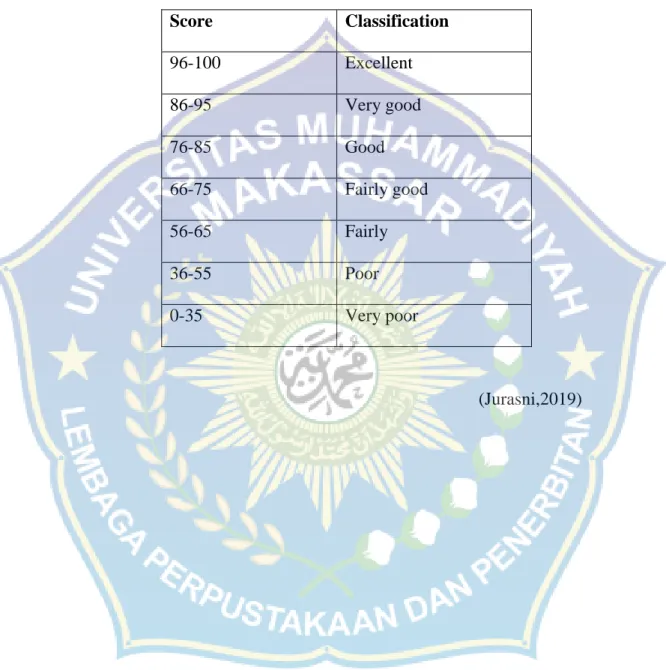
Findings
The Students’ Vocabulary Improvement
Based on table 4.4 above showed that the percentage and frequency of students' pre- and post-test. While in the post-test showed that the percentage and frequency of the students post-test. Table 4.5 showed that the frequency and percentage of students' vocabulary especially about verb, noun and adjective in pretest 23 students was good, but needs to be improved more.
Table 4.6 Frequency and percentage of students' vocabulary on verbs, nouns and adjectives in the post-test. Table 4.6 showed that the frequency and percentage of students' vocabulary, especially on verbs, nouns and adjectives, in the post-test of 23 students was good, but still needs further improvement. Table 4.5 showed that students made progress on the post-test, with the post-test being greater than the pre-test.
To know the significance level of the pre- and post-test, the examined used t-test analyzes at the significance level (p) = 0.05 with the degree of freedom (DF) = 22, because the sample consisted of 23 students (N-1 =22).
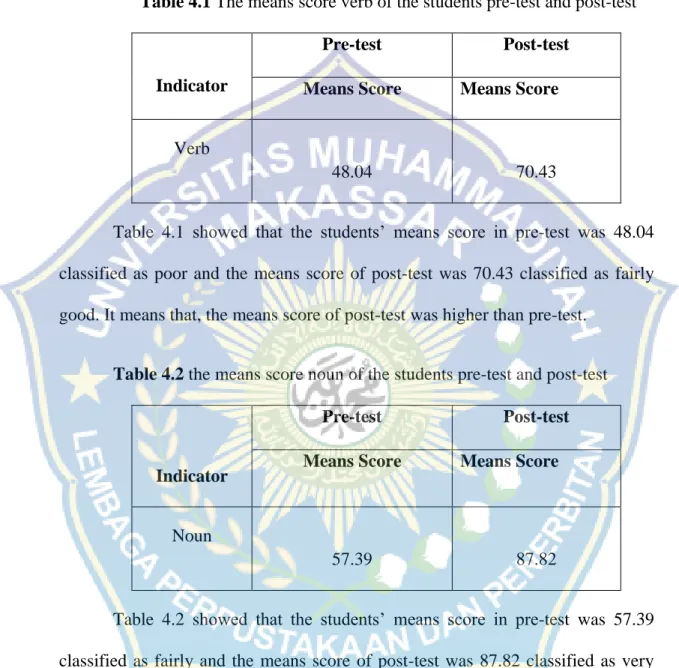
Discussion
According to Joanne Jasmine and Pamela Schiesl As seen in the triangulation of this project, word wall activities may have been a factor that helped build and strengthen high frequency vocabulary, leading to the increase in words read per minute. The activity that was most successful, as seen in the interview and observation checklist, was Be the Teacher. Based on the results of data, it was found that the application of word wall strategy successfully improved students' vocabulary achievement.
The finding of this study is that the Word Walls strategy can help students improve their vocabulary. By using this Word Walls strategy, students' vocabulary scores continued to increase from the reading test to the posttest. From the description of the collected data in the previous paragraphs, the students' mean score on the pre-test verb was 50.39, the pre-test noun was 66.95, and the pre-test adjective was 42.60 and the students' average score on post-test verb was 76.47, post-test noun was 86.08 and post-test adjective was 67.82 and from pre-test to post-test the verb can improve by 51 .
The pre-test standard deviation score was 7.23, the post-test standard deviation score was 71.33, and the t-test value was 114.1. Qualitative data taken from the observation sheet and the questionnaire also showed that students are interested in vocabulary using the word wall strategy, as the word wall strategy can be a solution for them in dealing with vocabulary learning difficulties. The strategy was very useful because it helped the students to improve their vocabulary which was due to the lack of English words.
What is the conclusion based on the data analysis and findings in the previous chapter.
Conclusion
And from pre-test to post-test, the verb can be improved by 51%, the noun can be improved by 29%, and the adjective can be improved by 59%.
Suggestion
The Effectiveness of Using Word Wall Media Students Vocabulary Mastery of Eighth Grade in MT's Negeri Bandung. The effect of using interactive word walls to teach vocabulary to middle school students (Doctoral dissertation, UNIVERSITY OF NORTH F LORIDA).
TUJUAN PEMBELAJARAN
MODEL/METODE PEMBELAJARAN
MEDIA, ALAT DAN SUMBER BELAJAR
LANGKAH-LANGKAH KEGIATAN PEMBELAJARAN
- Pertemuan pertama Kegiatan awal
- Pertemuan ke-2 Kegiatan awal
- Pertemuan ke-4
- Pertemuan ke-5 Kegiatan awal
- Pertemuan ke-6 Kegiatan awal
Tanyakan kepada siswa apakah sudah mempelajari materi yang telah dibahas sebelumnya yaitu media dinding kata. Peneliti memberikan kalimat yang berisi kosa kata kepada siswa untuk ditulis menggunakan dinding kata dan dibaca. Guru melakukan tanya jawab terkait kosakata dalam tes dengan menggunakan media dinding kata.
Guru menanyakan hal-hal yang belum diketahui siswa tentang kosa kata dengan menggunakan media dinding kata. Guru memberikan motivasi dengan mengaitkan pembelajaran dengan materi sebelumnya, apa yang dipelajari minggu lalu. Siswa memperhatikan petunjuk guru kemudian mendengarkan pengucapan gambar atau ilustrasi yang ditampilkan.
Guru memberikan post-test berupa soal tertulis di atas kertas dengan menggunakan word wall, hal ini bertujuan untuk melihat tingkat kemampuan siswa dalam menguasai kosa kata dalam kehidupan sehari-hari. Guru meminta siswa untuk terus belajar di rumah tentang cara mengucapkan dan memahami arti kosakata yang telah dipelajari sebelumnya. Menyarankan siswa untuk terus menggunakan media dinding kata agar mereka dapat meningkatkan penguasaan kosakatanya.
PENILAIAN
Mean score of pretest and posttest
The students’ improvement vocabulary
The students improvement vocabulary verb
The students improvement vocabulary noun
The students improvement vocabulary adjective


